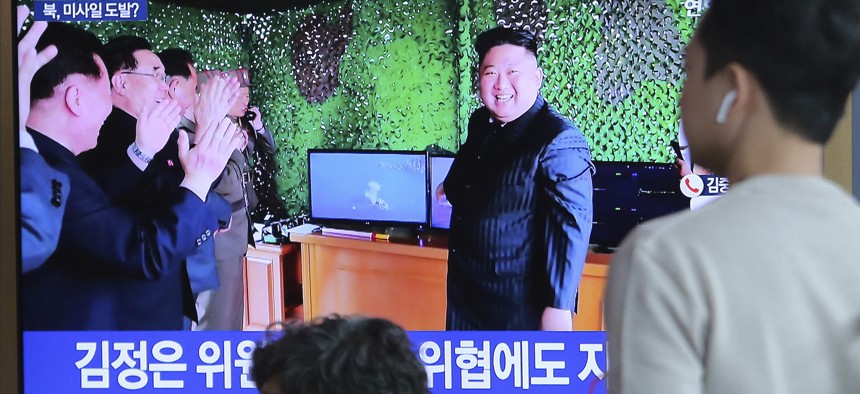
On May 5, 2019, people at a Seoul railway station watch a TV showing a photo of North Korean leader Kim Jong Un after North Korea's missile launch. AP Photo/Ahn Young-joon, File
Trump’s Bet on Kim Might Not Pay Off
All that’s preventing the collapse of talks is that North Korea’s missiles haven’t flown far enough yet.
President Donald Trump claimed his deal-making prowess and great relationship with Kim Jong Un had averted a devastating war and neutralized the threat from North Korea’s nuclear weapons. South Korean President Moon Jae In said he was building an “irreversible and lasting peace” on the Korean peninsula.
What’s become glaringly obvious, however, is that all this progress was as provisional as Kim Jong Un’s promise last spring to halt tests of nuclear weapons and long-range missiles.
The spectacular summits between the North Korean leader and his American and South Korean counterparts, the lofty joint statements that emerged from them, the Trump-Kim love letters and demolitions of a nuclear-test site and guard posts along the border between the Koreas—all of it was resting on an exceedingly fragile foundation, a foundation that is starting to crumble.
We’ve now descended to the point at which all that is keeping diplomacy with North Korea from collapsing is how many miles its missiles are flying.
Angered and humiliated by Trump’s decision to walk away from their second summit in Vietnam in February, Kim has gradually been dialing up the pressure on the United States and its allies. He’s reminding audiences at home and abroad that he’s quite capable of renewing his arms buildup in earnest if he doesn’t get his way in nuclear talks. (At the summit, Trump rejected North Korea’s offer to dismantle a nuclear facility in exchange for the lifting of most international sanctions against Pyongyang.)
Related: The Plan to Resurrect the North Korea Nuclear Talks
Related: After Raising the Stakes for North Korea Summit, Trump Walks Away
Related: Deter? Detente? NATO Has Lessons for the North Korean Conundrum
“North Korea’s military posturing is partially for domestic political consumption and partially an effort to complicate politics for Trump and Moon to elicit concessions,” Leif-Eric Easley, a professor at Ewha Womans University in Seoul, told me. “But while the Kim regime is likely aiming its provocations just below the threshold for a response from the U.S. and its allies in terms of increasing sanctions or scaling up military exercises, it may miss the mark.”
Ahead of the Vietnam summit came the rebuilding of a rocket-launch site that Kim had partially demolished. Then came the test of a mysterious conventional weapon in April, the firing last weekend of what the South Korean government euphemistically referred to as “projectiles” that traveled between 45 and 125 miles, and the launch this week of two short-range missiles that flew 260 and 170 miles, respectively—after more than 500 days of no testing. To make sure the message wasn’t lost on the Americans, the latest weapons demonstration came as Trump’s North Korea envoy, Stephen Biegun, was visiting South Korea and as the U.S. military tested a nuclear-capable intercontinental ballistic missile, or ICBM, in California.
What Kim hasn’t done yet is break last year’s vow and resume nuclear and long-range missile tests, the actions that nearly precipitated a military conflict between the United States and North Korea in 2017 as the North refined its capability to target the U.S. homeland with nuclear-tipped ICBMs.
On Sunday, in a move that must not have been especially heartening for U.S. allies in the crosshairs of North Korea’s firepower displays, U.S. Secretary of State Mike Pompeo signaled that merely letting loose rocket launchers and short-range ballistic missiles wasn’t enough to sway the United States off its diplomatic course. But he also suggested that any tests of weapons that directly threaten the United States could torpedo the talks. Kim’s testing moratorium was focused “on intercontinental missile systems, the ones that threaten the United States for sure,” he noted.
Kim is headed in that dangerous direction, even if he’s still a ways off, having given Trump a year-end deadline to adopt a more flexible approach to negotiations. The U.S. administration’s current position, which has only become more deeply entrenched since the Vietnam summit, is to maintain sanctions until North Korea fully gives up its weapons of mass destruction.
North Korea’s leader “has said that if the U.S. doesn’t change its position by the end of the year, they’re going to find a ‘new’ way, and I think what we’re starting to learn is that the new way is going to look a lot like the old way,” the nuclear-nonproliferation expert Jeffrey Lewis told me. “I don’t know how one can look at this particular trajectory and conclude that we’re headed anyplace other than an ICBM test, probably early next year if nothing changes.”
While the precise red line for the United States remains undefined, the Trump administration seems to be taking the approach of “you’ll know it when you see it,” Lewis told me. But the problem is that “they don’t want to see it. They really tried to avoid admitting that there was a missile on Saturday. Everybody insisted on calling them ‘projectiles’ … All I know is one of the projectiles was one meter in diameter and large enough to carry a nuclear warhead … It’s just not the North Korean way to go from zero to 60.”
The talks, in fact, might well unravel even before Kim gets to an ICBM test. North Korea is no longer cooperating with South Korea and the United States on the joint recovery of the remains of soldiers who died during the Korean War, a confidence-building measure Trump has often cited as a sign of success alongside the suspension of weapons tests. And the Trump administration is taking a harder line on sanctions, despite sporadic efforts by the president to soften the blow. On Thursday, the Justice Department announced the seizure of a North Korean ship alleged to have sold coal in violation of international sanctions, though the action against the vessel occurred before the past week’s spate of rocket and missile tests.
“I don’t think [the North Koreans are] ready to negotiate,” Trump conceded that same day, sounding uncharacteristically pessimistic about a process he has championed as one of the great achievements of his presidency.
South Korea’s president, who has repeatedly gotten derailed U.S.–North Korea talks back on track in the past, hasn’t managed to meet with Kim (or, as far as is publicly known, speak with the North Korean leader), even though Trump specifically asked Moon to consult with Kim and help chart a way forward after the Vietnam summit collapsed.
If negotiations fall apart and North Korea returns to expanding its nuclear-weapons arsenal (a program it has quietly continued to work on while negotiating with the United States), it would leave hopes of peace and denuclearization on the peninsula in tatters. It would also raise the risk of military conflict, whether by design or by accident, between the United States and North Korea.
The U.S. president, for his part, doesn’t appear to be giving up on diplomacy just yet. Kim “knows that I am with him & does not want to break his promise to me. Deal will happen!” Trump tweeted over the weekend. What the message underscored, however, is just how delicate that diplomacy remains: A deal hasn’t yet happened, it’s unclear what exactly Trump’s friendship is worth to Kim, and much is riding on a promise from the North Korean leader that is rarely elaborated in full.
NEXT STORY: How Authoritarians Manipulate Elections




